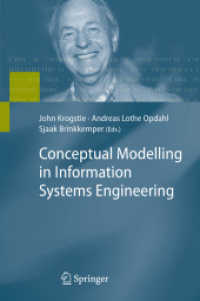- ホーム
- > 洋書
- > 英文書
- > History / World
Full Description
Through close examination of a set of educational works discovered among the Dunhuang manuscripts, this book presents new insights into the literary training undertaken by the elite of medieval China. In their contents and structures, these works tell us what parts of the literary and cultural inheritance the elite were expected to learn and how they learned them.
The material aspects of these manuscripts—including handwriting, copying errors, and paratextual additions—show how students in Dunhuang used and reproduced them. What emerges is a picture of a literary education that is more diverse in its sources, and also more haphazard, than previously imagined.
Contents
Contents
Acknowledgments
List of Tables and Figures
Manuscripts Cited
Introduction
1 The Dunhuang Context
2 Literary Training and the Literate Elite
3 Managing Literary Information
4 Overview of Shapters
5 Some Conventions
1 Kaimeng yaoxun: A Foundation for Literary Training
1 Introduction
2 Documents
3 Content: What Kaimeng yaoxun Teaches
4 Structure: What Makes Kaimeng yaoxun "Easy to Understand and Hard to Forget"?
5 Using Kaimeng yaoxun: Evidence from Textual Variation
6 Case Study: P.2578
7 Managing Information: Kaimeng yaoxun as Literary Training
2 Qianzi wen as Mnemonic Scaffold
1 Introduction to Qianzi wen
2 Qianzi wen
3 Medieval Annotations to Qianzi wen
4 Liuzi qianwen
3 Yudui: Parallel Sayings as Tool and Method
1 Introduction
2 Documents and Formats
3 Structure and Content
4 Variation, Production, and Use
5 Yudui as Information Management
4 Zachao: A Complex Miscellany
1 Introduction
2 The Documents
3 Organizational Structure
4 Categories of Content
5 Managing Information
6 Textual Variation
7 Layout, Format, and Use
8 Parallels
5 Tuyuan cefu: A Primer for Exams and Officialdom
1 Introduction
2 The Bibliographic Record
3 Dunhuang Documents
4 Du Sixian's Preface
5 Content and Structure: "Deliberating the Feng and Shan Sacrifices"
6 Using Tuyuan cefu
7 Tuyuan cefu In (and Out) of Context
Conclusion
1 Implications
Bibliography
Index







